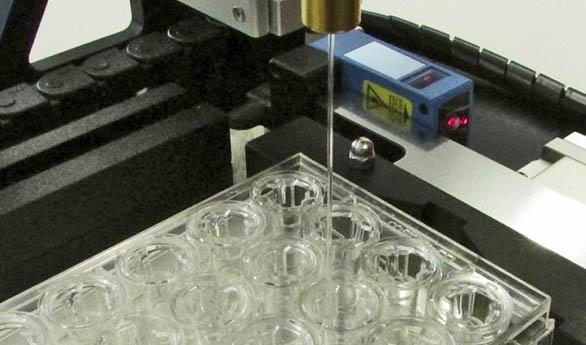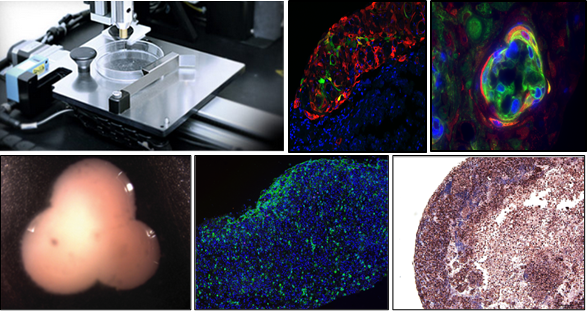 Bioprinting is in our future. No longer the stuff of sci-fi dreams, the technology is taking a true hold in today’s world — and even in the dictionary. By bringing 3D printing together with living cells to create viable organic structures, companies like San Diego, California-based Organovo (NYSE: ONVO) are changing the shape of medical technology.
Bioprinting is in our future. No longer the stuff of sci-fi dreams, the technology is taking a true hold in today’s world — and even in the dictionary. By bringing 3D printing together with living cells to create viable organic structures, companies like San Diego, California-based Organovo (NYSE: ONVO) are changing the shape of medical technology.
Just this past November, Organovo announced that its 3D printed human liver tissue was commercially available, under the exVive3D name. The tissue, currently intended for use in pre-clinical drug trials, can significantly expedite the drug discovery process in the pharmaceutical industry, potentially bringing life-saving medicines to market that much sooner.
Organovo is at it again, just a few months later, today announcing data on the world’s first 3D bioprinted fully cellular kidney tissue, unveiled at the Experimental Biology conference in Boston.
“The first 3D bioprinted human kidney tissue hopes to help millions of people with kidney disease by providing a new model for medical research and drug testing,” Madeline Hirshan, Account Coordinator at Little Dog Communications, told 3DPrint.com in an email announcing Organovo’s development. “…Known as the silent disease, more than 25 million people in the United States are living with kidney disease, a growing epidemic (for context: 13M people are living with cancer and 29M people have diabetes).”
 The kidney tissue represents an important development in bioprinting, as Organovo proves its model for more than one type of human organ. The bioprinted human kidney tissue will also be utilized in pharmaceutical R&D, representing an enhancement on currently available models for testing which are not all that close to the actual human body. Furthermore, while current tissues are able to survive for only a few days in laboratory conditions, Organovo’s kidney tissue can last “at least two weeks.”
The kidney tissue represents an important development in bioprinting, as Organovo proves its model for more than one type of human organ. The bioprinted human kidney tissue will also be utilized in pharmaceutical R&D, representing an enhancement on currently available models for testing which are not all that close to the actual human body. Furthermore, while current tissues are able to survive for only a few days in laboratory conditions, Organovo’s kidney tissue can last “at least two weeks.”
With so many people both in the US and the world at large suffering from kidney disease, this development could be big news. Three-dimensional, accurately replicated, fully cellular models will allow for testing of drug toxicity and efficacy and for the modeling of disease behavior in living tissue.
“Our bioprinted human kidney tissue represents a significant technical advance over the simple monolayer cell line cultures that predominate today,” said Organovo’s Chief Technology Officer and Executive Vice President of Research and Development, Dr. Sharon Presnell. “The histologic and functional features of the initial prototypes are compelling, and the in vitro durability of the system will likely enable the assessment of drug effects at chronic, physiologically relevant doses. Furthermore, the cellular complexity of the system will likely support mechanistic investigations into drug responses, including end points that have been difficult or impossible to assess in vitro, including tubular fibrosis and post-injury recovery.”
The data announced today is still preliminary, but ultimately the kidney tissue will be added to the company’s line of exVive3D tissues, along with the now-available exVive3D Liver. Both tissues are created using NovoGen, Organovo’s proprietary bioprinting platform. Currently, Organovo estimates that the kidney tissue will see its commercial release “in the latter half of calendar year 2016.”
“Kidney represents an ideal extension of Organovo’s capabilities to 3D bioprint organ tissues that can be tremendously useful in pharmaceutical research,” said Organovo’s Chairman and Chief Executive Officer, Keith Murphy. “The results released today admirably demonstrate a proof of concept that kidney is on the way to becoming another core commercial tissue for Organovo. The product that we intend to build from these initial results can be an excellent expansion for our core customers in toxicology, who regularly express to us an interest in having better solutions for the assessment of human kidney toxicity.”
While both tissues in the exVive3D line are or will be intended for drug trials, both represent critical stepping stones as science nears the now seemingly inevitable: bioprinting full human organs that are viable for transplant into live patients.
Let us know what you think about this latest bioprinting announcement in the Organovo Announces 3D Bioprinted Kidney Tissue forum thread over at 3DPB.com.

Subscribe to Our Email Newsletter
Stay up-to-date on all the latest news from the 3D printing industry and receive information and offers from third party vendors.
You May Also Like
New Report: Semiconductor Industry to See $1.4B in 3D Printing Revenues by 2032
“The semiconductor sector has become the most strategically significant area of global industry.” Truer words are hard to come by when it comes to the modern world, and they are...
Will Photonic-Crystal Lasers Revolutionize 3D Printing?
Powder bed fusion (PBF) for metals and polymers predominantly utilizes lasers as the primary heat source. Some directed energy deposition (DED) technologies also employ lasers, while various vat polymerization methods...
3D Printing Unpeeled: Orbex Investment, IndoMIM and HP, Ultrasonic Waves
INDO-MIM has bought three HP Metal Jet S100 printers, operating two in India and one in Texas. This is a win for HP because the company has deep experience in...
3D Printing Webinar and Event Roundup: April 21, 2024
It’s another busy week of webinars and events, starting with Hannover Messe in Germany and continuing with Metalcasting Congress, Chinaplas, TechBlick’s Innovation Festival, and more. Stratasys continues its advanced training...































